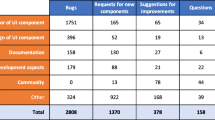Abstract
The article discusses the theory and practice of software development in the light of design theory. It tries to show that the design process cannot be forced into a predefined operational sequence. To underline this, the history of design methods is retraced, showing that such approaches were abolished not only in practice, but also the theory of design. The essay then discusses the cognitive framework of contemporary design theory and closes with the proposal that informatics should redefine itself as a design discipline in order to tackle the problems of interaction design.
Zusammenfassung
Der Text diskutiert die Theorie und Praxis der Softwareentwicklung im Lichte aktueller Designtheorie. Es wird zu zeigen versucht, dass sich der Designprozess der operationalen Formalisierung entzieht. Dazu wird die Geschichte der Designmethoden nachgezeichnet, die zeigt, dass solche Ansätze nicht nur in der Praxis, sondern auch in der Theorie gescheitert sind. Der Aufsatz diskutiert dann die kognitiven Rahmenbedingungen aktueller Designtheorien und schließt mit dem Vorschlag, dass sich die Informatik als Designdisziplin verstehen muss, um die Probleme des Interaktionsdesign wirklich lösen zu können.
Résumé
Ce texte s’interroge sur la théorie et la pratique du développement de logiciels à la lumière de la théorie de design actuelle. Il tente de montrer que le processus de design se soustrait à la formalisation opérationnelle. L’histoire des méthodes conceptuelles est par ailleurs retracée, qui montre que de telles démarches n’ont pas seulement échoué dans la pratique, mais aussi en théorie. L’article se penche sur les conditions cadres cognitives des théories de design d’aujourd’hui et s’achève sur la proposition selon laquelle l’informatique doit s’entendre comme discipline de design pour pouvoir véritablement résoudre les problèmes du design d’interaction.

Similar content being viewed by others
Notes
Nevertheless, it would be very interesting to see more discussion of the design of interactive systems. Architecture has developed a culture of critique and discussion about their artefacts. It is high time that informatics followed this lead and started a broad debate about interactive artefacts produced by its agents.
Unfortunately, there is a huge lack in design instruments that fit the sketching of interaction. The Swedish interaction design researcher Jonas Löwgren and the Author of this article have started a website (Löwgren et al. 2006) to collect examples, best practices, research questions etc. on interaction sketching.
“Beyond Calculation” is the title of a collection of essays edited by Peter Denning and Robert Metcalfe. One of the essays, Terry Winograds “The Design of Interaction” [23], coined the term “Interaction Architect”.
References
Alexander C (1963) The determination of components for an Indian village. In: Jones CJ, Thornley D (eds) Conference on design methods. Pergamon Press, Oxford
Alexander C (1964) Notes on the synthesis of form. Harvard University Press, Cambridge
Alexander C (1971) The state of the art in design methods. In: DMG Newsletters 5(3)
Buchanan R (1992) Wicked problems in design thinking. In: Design issues, vol 8(2)
Buxton B (2006) What sketches (and prototypes) are and are not. Workshop at CHI06, 22–27
April, Montreal, Canada. Position Paper at www.kid.rcast.u-tokyo.ac.jp/chi06-sketch-ws/final-position-papers/Buxton-SketchesPrototypes.pdf
Reproduction of a slide used by William Buxton in a talk (2004) The role of design in software product development, KMDI, Toronto, April 22
Cross N (1984) Developments in design methodology
Cross N (2001) Design/science/research: developing a discipline. Keynote on the 5th Asian design conference—international symposium on design science, 11–13 October, Seoul National University
Dewey J (1938) Logic: the theory of inquiry. H. Holt and Company, New York
Floyd C (1992) Software development as reality construction. Springer, Berlin Heidelberg New York
Gasparski WW (1990) On the general theory (praxeology) of design. In: design methods and theories, 24(2)
Gedenryd H (1998) How designers work—making sense of authentic cognitive activities. Ph.D. dissertation, Lund University Cognitive Science http://www.lucs.lu.se/People/Henrik.Gedenryd/HowdesignersWork/index.html
Grant D (1979) Design methodology and design methods. In: design methods and theories. J DMG, 13(1)
Hewett TT, Baecker R, Card SK, Carey T, Gasen JB, Mantei M, Perlman G, Strong G, Verplank W (1992, 1996) ACM SIGCHI curricula for human–computer interaction. Report of the ACM special interest group on computer–human interaction (SIGCHI) curriculum development Group. http://www.acm.org/sigchi/cdg
Jones JC (1970) Design methods. Van Nostrand Reinhold, New York
Kapor M (1990) A software design manifesto. In: Winograd T, with Bennett J, De Young L, Hartfield B (1996) Bringing design to software, Addison-Wesley, USA
Lawson B (19801, 19973) How designer think. Butterworth Architecture, London
Lawson B (1994) Design in Mind. Elsevier, Amsterdam
Löwgren J, Purgathofer P (2006, ongoing) sketching for interaction, Weblog at twoday.tuwien.ac.at/interactionsketching
Naur P, Randell B (eds) (1969) Software engineering: report of a conference sponsored by the NATO Science Committee, Garmisch, Germany, 7–11 October 1968, Brussels, Scientific Affairs Division, NATO
Schön D (1983) The reflective practitioner. Bibliography review 63, MIT Press, Cambridge
Wells D (2003) Extreme programming. http://www.extremeprogramming.org
Winograd T (1997) The design of interaction. In: Denning PJ, Metcalfe RM (eds) Beyond calculation: the next fifty years of computing, Copernicus Springer, New York
Author information
Authors and Affiliations
Corresponding author
Rights and permissions
About this article
Cite this article
Purgathofer, P. Is informatics a design discipline?. Poiesis Prax 4, 303–314 (2006). https://doi.org/10.1007/s10202-006-0029-0
Published:
Issue Date:
DOI: https://doi.org/10.1007/s10202-006-0029-0




